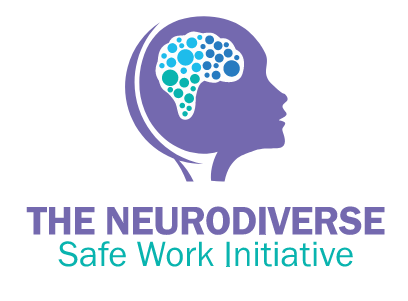1. Understanding Neurodiversity in the Modern Workplace
Neurodiversity is a concept that recognises the natural variations in human brain development and functioning. It includes presentations such as Autism, ADHD, Dyslexia, Dyspraxia, Tourette Syndrome, and many others. It’s common for an individual to have more than one type of neurodivergence. So, for example, an Autistic person might also have traits of ADHD and Dyslexia or a person with ADHD may also experience Dyscalculia and Developmental Language Disorder (DLD).

In a workplace setting, neurodiversity inclusion means understanding, accepting and valuing all the different ways people process information, communicate, and engage with their environment.
For Australian employers, this is more than just an HR topic, it’s a pressing issue tied to both legal duty and business sustainability. Failing to recognise the value of neurodivergent workers often leads to exclusion, underemployment, and psychological harm. Conversely, embracing neurodiversity can bring about powerful transformations in innovation, culture, and team dynamics.
2. Employer’s Duty of Care – More Than Just a Legal Obligation
In Australia, every employer has the primary duty of care under the relevant Work Health and Safety Acts to ensure, so far as is reasonably practicable the health and safety of workers. This is a duty that cannot be delegated to a third party. It includes both physical and psychological health.
For neurodivergent workers, who often experience different sensory, communication, or processing challenges, and are more vulnerable to experiencing psychological ill health, this means more than avoiding harm, it means proactively creating an environment where they can work well and function safely.
Psychological Safety is a Health and Safety Requirement

The rise in awareness around psychosocial hazards, including stress, burnout, isolation, and exclusion, has led to a sharper focus on psychological safety. In 2022, Safe Work Australia introduced model WHS regulations on managing psychosocial risks, urging employers to assess and mitigate factors that may harm mental wellbeing.
For neurodivergent workers, a lack of inclusion, misunderstanding, or forced conformity to neurotypical standards can dramatically increase the risk of psychological distress. Addressing these issues is not a “nice to have”; it’s both a legal and moral obligation.
Risks of Psychological Illness Among Neurodivergent Workers
Research consistently shows that neurodivergent individuals are at greater risk of anxiety, depression, and workplace stress. These risks are exacerbated when organisations fail to offer proper support, reasonable adjustments, or inclusive culture. In workplaces that don’t understand or accommodate cognitive differences, neurodivergent employees mask their traits, suppress feedback, or withdraw entirely, leading to performance issues, presenteeism, or even departure.
3. The Business Case for Neuro-Inclusivity
Building a neuro-inclusive workplace isn’t just about meeting legal requirements, it’s about unlocking potential and enhancing performance.
Several studies, including those by Deloitte and Harvard Business Review, confirm that cognitively diverse teams:
- Are more innovative and problem-solving oriented
- Exhibit higher levels of engagement and loyalty
- Drive better decision-making outcomes
- Improve brand reputation and customer loyalty
Organisations like SAP and IBM have pioneered neurodiversity hiring initiatives and report improvements in efficiency, creativity, and employee morale.
The Cost of Inaction – Legal, Financial, and Cultural Risks

Ignoring neurodiversity can result in:
- Fair Work claims for unfair or constructive dismissal
- Human Rights Commission claims for discrimination
- Workplace Health and Safety Regulator complaints about unsafe practices
- Increased workers’ compensation claims for personal (including psychological) claims that arise in the course of employment
- Higher turnover and recruitment costs
- Low team morale and poor mental health metrics
- Reputational damage
In Australia, several high-profile legal cases have demonstrated the real risks for employers who fail to meet their psychological safety obligations, especially regarding neurodivergent workers.
4. Strategies for Building a Neuro-Inclusive Workplace
Creating a workplace that is truly inclusive requires more than policies and noise-cancelling headphones. It demands cultural transformation. Here’s how to get started:
i. Invest in Neurodiversity Awareness Training – Educate your leadership and staff on what neurodiversity means. Training programs should address unconscious bias, sensory sensitivities, and communication preferences.
ii. Design Inclusive Recruitment and Onboarding Processes – Rethink job descriptions, interview formats, and assessment tasks. Offer candidates alternative ways to demonstrate competence, such as work trials or portfolios.
iii. Adjust the Physical and Digital Workplace Environment – Provide quiet zones, noise-cancelling options, and user-friendly digital interfaces. Flexibility in the physical space goes a long way in reducing stress.
iv. Promote Flexible Work Options – Allow for remote work, flexible hours, and breaks. Neurodivergent workers can thrive with autonomy over their schedules and environments.
v. Embed Neurodiversity into Workplace Culture – Incorporate inclusive language, share employee stories, and encourage Employee Resource Groups (ERGs) to foster community and belonging.
vi. Use the Neurodiverse Safe Work Self-Assessment Checklist – This assessment tool helps employers benchmark inclusivity, identify gaps, and measure progress over time, and provides a useful planning tool to make improvements in identified areas.
vii. Create Feedback Loops for Continuous Improvement – Invite input from neurodivergent workers regularly. Make space for anonymous feedback and ensure actions are taken in response.
5. Case Studies: What Australian Employers Are Doing Right
Several Australian organisations have embraced neuro-inclusivity and are already reaping the benefits. These examples demonstrate that with the right strategy, change is not only possible—it’s impactful.
Department of Home Affairs – Autism Hiring Program

The Australian Government’s Department of Home Affairs has a dedicated autism hiring initiative. They redesigned their recruitment process to remove traditional barriers and focused on strengths-based assessment. As a result, the department reported increased productivity, enhanced analytical skills in their teams, and improved morale across staff.
Westpac – Tailored Adjustments for Cognitive Inclusion

Westpac’s commitment to workplace diversity includes a strong focus on neurodivergence. The bank offers flexible work arrangements, sensory-aware workspace options, and regular neurodiversity awareness training. Their inclusive culture has resulted in better employee retention, particularly among neurodivergent staff who value psychological safety and understanding.
IBM Australia – Neurodiversity at Work Initiative

IBM’s global “Neurodiversity at Work” initiative is active in Australia and focuses on hiring, onboarding, and retaining neurodivergent talent. Their success lies in adapting processes and providing ongoing coaching to both managers and team members. Productivity gains, faster turnaround on projects, and richer team collaboration have all been reported.
6. Common Pitfalls and How to Avoid Them
Even well-meaning employers can fall into traps when attempting to support neurodivergent staff. Here are some to avoid:
i. Assuming all neurodivergent individuals need the same adjustments – even with universally designed, inclusive business systems and processes, sometimes neurodivergent workers will need something different to accommodate a particular need or challenge.
Solution – Tailor support based on individual needs and preferences, document what’s been agreed to and follow-up with the worker to make sure it’s working out for them.
ii. Focusing solely on visible disabilities – It is easier to make adjustments for a worker who has a visible disability. But invisible disabilities whether physical, psychological or neurodivergent can be harder to accommodate. We don’t see the challenges the person experiences and it’s not obvious what support they need.
Solution – Most of the challenges of neurodivergence are invisible. But most people who disclose their difference and ask for help from their employer do not do so lightly. Often, they fear discrimination and judgment and most never ask for help. If a worker has made the decision to ask for help, it has taken them great courage and it is a decision they have not taken lightly. Prioritise open dialogue and trust.
iii. Waiting for a formal diagnosis before offering support – For most adults in Australia who suspect they may be neurodivergent, a diagnosis is simply inaccessible to them due to the shortage of specialists qualified to undertake the testing and the costs involved. Or the individual may have been given a diagnosis in childhood, but this report is no longer available to them. Requiring a neurodivergent worker to provide proof of their diagnosis before making adjustments or offering support, when this proof is inaccessible to them is a discriminatory practice.
Solution – Act on observed needs rather than formal labels. Discuss the issues with the individual, document and implement the adjustments they’ve asked for, or negotiate an acceptable alternative and follow up with them to make sure it’s working out for them.
iv. Implementing a one-off training session with no follow-up – Neurodiversity Awareness sessions are a valuable way of dispelling misinformation and challenging unconscious bias, and they are a good way to begin the conversation. But alone they are not sufficient to bring about cultural or systemic change.
Solution – Integrate neurodiversity into ongoing learning and development.
7. Frequently Asked Questions About Neuro-Inclusivity at Work

Do employers in Australia have a legal duty to support neurodivergent employees?
Yes. Under the Work Health and Safety Act, employers must protect the psychological and physical health of all workers, so far as reasonably practicable, including neurodivergent individuals. Additionally, the Disability Discrimination Act prohibits unfair treatment based on cognitive differences.
How can I tell if someone is neurodivergent if they haven’t disclosed it?
You can’t, and you shouldn’t assume. But why do you need to know? Forget labels. Labels can be misleading. Focus instead on creating a safe and inclusive workplace environment and community where the adjustments most people need are designed into the system and don’t require self-disclosure by the worker. In such an environment, individuals that need some extra support will feel safer in making that disclosure and asking for help, knowing that they are valued and trusted. Make inclusivity the default, not the exception.
Are reasonable adjustments required by law?
Yes. Employers are legally obliged to provide reasonable adjustments unless it causes unjustifiable hardship. These might include flexible hours, communication support, or workspace modifications. Employers also have the Primary Duty of Care to ensure, so far as reasonably practicable the health and safety of workers. Employers must consider the different ways that workers perceive and respond to risk and experience the physical environment when managing risk.
What’s the difference between ‘reasonable adjustments’ and ‘neuro-inclusion’?
Reasonable adjustments are reactive accommodations, often triggered by the worker’s self-disclosure. Neuro-inclusion is a proactive, systemic approach that designs environments and cultures to include everyone from the start.
Where can employers access help to implement neuro-inclusive practices?
The Neurodiverse Safe Work Initiative offers a range of neurodiversity training programs both in person and online, from neurodiversity awareness sessions to our accredited Neurodiverse Safe Work Foundations Course II.
We provide complimentary resources including the Neurodiverse Safe Work Self-Assessment Checklist and a 30-minute consultation. We also offer Coaching Programs for neurodivergent workers using the Neurodiversity Workplace Profiler created by Do-IT Solutions and adapted to the Australian business context by us.
Government resources such as the Victorian Public Sector Commission’s Neurodiversity Toolkit and the Australian Public Sector Neurodiversity Community of Practice offer a range of useful tools and templates.
How do I measure the success of neuro-inclusion efforts?
Track engagement, retention, and performance metrics for neurodivergent employees. Engage with workers and use feedback tools, surveys, and audits like our Neurodiverse Safe Work Self-Assessment Checklist to identify improvement areas and benchmark progress.
Conclusion – Shaping the Future of Safe, Inclusive Workplaces in Australia
Neurodiversity isn’t a trend, it’s a workforce and human reality. Inclusion is a choice.
As awareness increases, diagnostic practices improve and more Australians receive a diagnosis of some form of neurodivergence, the need for inclusive, psychologically safe workplaces becomes urgent. By going beyond compliance, employers can not only meet their legal obligations but also position their businesses as leaders in innovation, empathy, and performance.
When employers honour their primary duty of care and prioritise psychological safety for all workers, including those who think and function differently, they unlock a powerful competitive advantage. Inclusion is no longer optional, it’s a core pillar of sustainable business.

